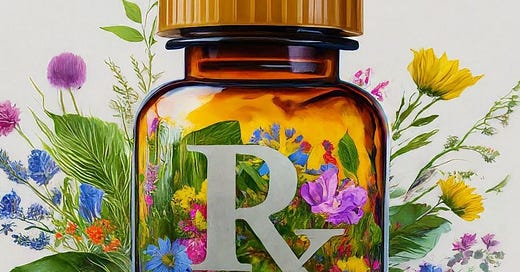About This Newsletter
Can plants be medicine? If this question was posed to the majority of our ancestors, the answer would be a resounding “yes.” In recent decades, however, modern medicine has made the answer to this question seem much more ambiguous. Concerns about pseudoscience, lack of peer-reviewed studies, cultural biases, and unintended toxicities are among many of the concerns expressed by modern physicians.
As an Internal Medicine board-certified physician, I share similar concerns for any medicine I recommend to a patient. The pharmaceutical medicines that I use for my patients in the hospital are chosen because of their chemical structure and ability to influence biochemical pathways that our health depends on. Because medical school and residency drilled the body’s biochemical pathways and chemical properties of modern-day medicine into my memory, I am able to understand precisely how plants can be medicine.
This newsletter will be a medium for me to share my findings on the medicinal properties of plants with an emphasis on historical use, biochemistry, and empirical evidence. This Substack is intended for anyone who wonders if certain plants could be medicine and if there is a scientific basis for this connection.
How I Got Into Plant Medicine
2020 was a year heavily marred by the pandemic. I was a year post-residency working as a hospitalist at a major hospital in Dallas. My days during this part of the COVID-19 pandemic were mainly spent working in the hospital wards and my evenings were mostly spent at home quarantining. Growing plants became a welcome hobby to spend my time. I grew all sorts of herbs ranging from lavender to mint to basil and vegetables including peppers, tomatoes, turmeric, and broccoli. As the son of Indian immigrants, I was exposed to Ayurvedic medicine which thoroughly describes the use of plants for medicinal purposes. But practicing as a physician in the United States, I looked at herbal medicine with skepticism despite its use by generations of my ancestors before me.
While caring for my turmeric plant, I wondered if it actually had medicinal properties. And if turmeric actually did, how many other plants were our ancestors correct about? My questions inspired me to take a class entitled Medical Ethnobotany taught by Dr. Giulia Friso of Cornell University. Thanks to Dr. Friso, I learned about the major phytochemicals that exist in plants: terpenes, phenolics, glycosides, and alkaloids. These phytochemicals are the foundation for how many natural remedies from ethnobotanical traditions around the world work. Plants make these chemicals for their own survival to deal with UV radiation, pathogens, predators, seed dispersal and other vital needs of the plant. When we ingest these active chemicals, they can exert significant effects on our body’s biochemical pathways with (generally) low toxicity. I soon realized in almost all successful human societies up until this point, it was well accepted that plants can be used for medicinal purposes. Many cultures had detailed understandings of the benefits, risks, and toxicities of plants similar to our understanding of modern pharmaceuticals.
In this Substack, I will examine plants from a variety of traditions originating from various parts of the world including India, China, Africa, South America, Europe and the Middle East. I will also evaluate plants utilized by Native American, Aboriginal, and many other indigenous/ancient cultures that used plants medicinally.
Nature’s Prescriptions
After learning about medicinal plants from all over the world, I started categorizing plants used by ancient societies with a legitimate biochemical mechanism that could be used in modern day. My list became so extensive that I decided to start an elective course at Texas A&M School of Medicine to teach this information to future physicians. It has been an absolute joy to share my findings with medical students and residents for the past four years through lectures and discussions. My goal has always been to expand this knowledge to the general public. I enjoy empowering people to take control of their own health through understanding the medicinal properties of plants.
After my friends Tariq and Tareen recommended I start a newsletter through Substack, I realized this could be an ideal medium to spread knowledge about medicinal plants through a scientific lens from a practicing academic physician. What I will be sharing has changed my personal health and the health of my patients, family, and friends. With the overbearing threats to human health that strain our modern healthcare system, we must be willing to explore unique and innovative solutions. Learning from the wisdom and experience of our ancestors seems like an excellent place to start.
I intend on writing articles that highlight different plants that have biochemical, historical, and practical use for modern medical issues. I would love for this to be a collaborative process with feedback, suggestions, and discussion.
Welcome to Nature’s Prescriptions.
Jason Joseph, MD, FACP




Love it! Excited for all of the learning from your posts!
Very interesting Jason. Learned a lot from this post. Looking for more post.
Good Job.